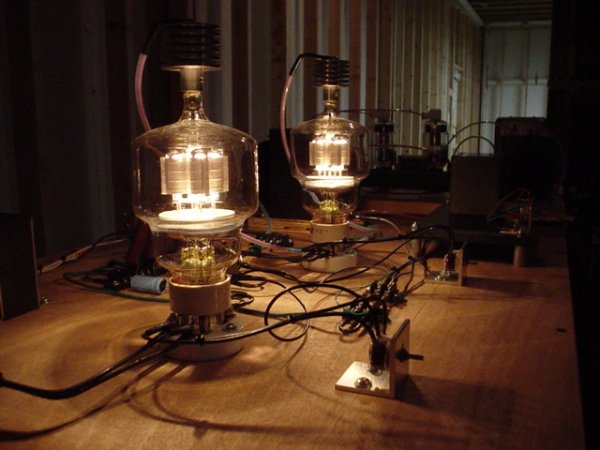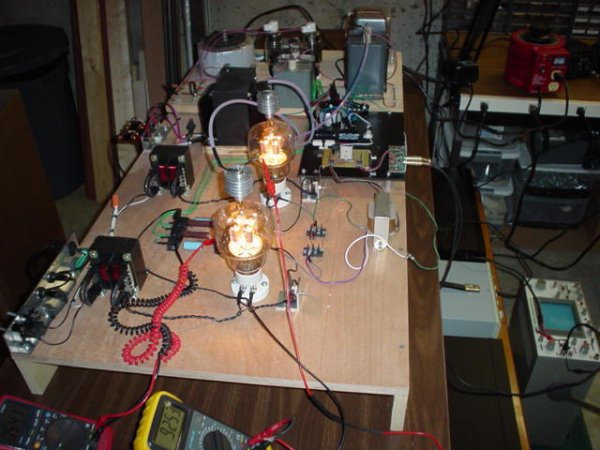Ceramic metal triodes
- Thread starter ack
- Start date
You are using an out of date browser. It may not display this or other websites correctly.
You should upgrade or use an alternative browser.
You should upgrade or use an alternative browser.
Yup, power amplifier tubes for kW RF transmitters. See e.g. http://www.rell.com/products/Electron-Tubes-Vacuum-Devices/Tetrode/4CX15000A-8281.html
I used to work on some of those 20KW transmitters back in the mid 70's. Very similar output tube.
Used their little sisters in ham transmitters, and their bigger (water-cooled) brothers in larger commercial transmitters. The big FM transmitters I saw used nitrogen-filled lines to the antenna for the 100 kW versions.
We had ten of those 20kw transmitters, with eight of them running at a time. We used hollow copper tubing 2 to 4 inches in diameter, sorry can't quite recall exact diameter. These all ran to the balan, then two combined frequencies ran out to each folded logarithmic antenna, four antennae were used in total.
In some places, but modern SS devices are moving on up... SiC, InP, etc.
@Steve -- Sounds neat, and very similar to what I saw. I was a helper/observer, could not do final tuning as I did (do) not have a 1st Class license.
@Steve -- Sounds neat, and very similar to what I saw. I was a helper/observer, could not do final tuning as I did (do) not have a 1st Class license.
Here's a video tour through a transmission facility. Note the tube removal at the 21 minute mark:
http://www.eevblog.com/2014/01/17/eevblog-569-tour-of-an-analog-tv-transmission-facility/
http://www.eevblog.com/2014/01/17/eevblog-569-tour-of-an-analog-tv-transmission-facility/
In some places, but modern SS devices are moving on up... SiC, InP, etc.
@Steve -- Sounds neat, and very similar to what I saw. I was a helper/observer, could not do final tuning as I did (do) not have a 1st Class license.
Don-tubes still rule at high power/high frequencies. Think megawatts in the GHz band.
Here's a video tour through a transmission facility. Note the tube removal at the 21 minute mark:
http://www.eevblog.com/2014/01/17/eevblog-569-tour-of-an-analog-tv-transmission-facility/
Wow! Fascinating, thanks! check out those the copper ground pipes!
Don-tubes still rule at high power/high frequencies. Think megawatts in the GHz band.
I understand, helped design some such systems, but for up to several kW SS is taking over if not already there.
I understand, helped design some such systems, but for up to several kW SS is taking over if not already there.
My world is high-power/high frequency and is the land where tubes still rule. SS was supposed to have taken over that world 20 years ago, than 10 years ago, and on and on. It will get there as people are trying to drag it kicking and screaming into the now.
Gotcha', yes. SS devices are simply not there for megawatt GHz systems; takes too many so signal distribution and thermal management is a nightmare compared to just using a big magnetron/klystron/whatever. I saw a SS 10 kW X-band xmtr at an AF lab and it was one ugly beast... Good luck getting it into a nose cone!
The pre-driver used superconducting filters, those were cool (ahem).
The pre-driver used superconducting filters, those were cool (ahem).
Gotcha', yes. SS devices are simply not there for megawatt GHz systems; takes too many so signal distribution and thermal management is a nightmare compared to just using a big magnetron/klystron/whatever. I saw a SS 10 kW X-band xmtr at an AF lab and it was one ugly beast... Good luck getting it into a nose cone!
The pre-driver used superconducting filters, those were cool (ahem).
I'm referring to shipboard applications. With regards to thermal management (which is an issue), you still have to deal with a giant heat signature.
Ship- or land-based systems all use tubes for the big beasts (0.01 MW and up) AFAIK, don't know where the low-power crossover to SS is now. Some, if not most, of the airborne systems do as well, and a number of satellite xmtrs (tubes are way more rad-hard than most SS devices). That is for single transmitters; a number of phased arrays and other distributed systems use SS but the power/module is well below a kW so even if the overall array is a MW no single module is within several orders of magnitude of that figure.
What do the big sonar systems use for outputs? I have been involved with most other xmtrs at some level but only the receive path of sonar systems, or analog procesing well before the output amps.
I saw the transmitter finals for an ULF system one time that was scary, must have been custom tubes. A pair was in push-pull in each transmitter cabinet and each tube was about 2' - 3' tall and about 18" - 24" in diameter.
What do the big sonar systems use for outputs? I have been involved with most other xmtrs at some level but only the receive path of sonar systems, or analog procesing well before the output amps.
I saw the transmitter finals for an ULF system one time that was scary, must have been custom tubes. A pair was in push-pull in each transmitter cabinet and each tube was about 2' - 3' tall and about 18" - 24" in diameter.
I'm guessing a pair of those in class-A audio service would be overkill, assuming you could get past the 1000 watt filament supply (per tube) requirements and the 7~12kv plate supply. And the forced air blowers to cool it all.
There was a fellow some years back who used a pair of Svetlana 3CX300A1 ceramic-planar triodes to get 100 watts PP....recall discussing the topology with him. Interesting project, but less fun if you can't see 'em glowing.
One of my past projects, Eimac 304TL, push pull class A, around 1200 volts on the plates. Electra-Print OPT, surplus Collins supply chokes, 3B28 rectification. Earliest attempts with mercury-vapor rectifiers led to some spectacular explosions. Great sound, but a tough way to get 75 class-A watts. Started accumulating parts to play with tubes of the external anode variety but never went further.


Birch-ply "breadboard" adds to the excitement when one of these projects goes up in flames.
Tom
There was a fellow some years back who used a pair of Svetlana 3CX300A1 ceramic-planar triodes to get 100 watts PP....recall discussing the topology with him. Interesting project, but less fun if you can't see 'em glowing.
One of my past projects, Eimac 304TL, push pull class A, around 1200 volts on the plates. Electra-Print OPT, surplus Collins supply chokes, 3B28 rectification. Earliest attempts with mercury-vapor rectifiers led to some spectacular explosions. Great sound, but a tough way to get 75 class-A watts. Started accumulating parts to play with tubes of the external anode variety but never went further.


Birch-ply "breadboard" adds to the excitement when one of these projects goes up in flames.
Tom
Similar threads
- Replies
- 0
- Views
- 439
- Replies
- 1
- Views
- 504
- Replies
- 6
- Views
- 757
- Sticky
- Replies
- 166
- Views
- 25K
Members online
- Dierkx1
- MarkusBarkus
- Jpowell
- Bobvin
- directdriver
- Kingsrule
- mtemur
- Salectric
- abeidrov
- Lee
- ationg
- Rexp
- guiver
- Joe Whip
- mainelotus
- bonzo75
- Walnut Horns
- SoundMann
- gian60
- ecwl
- Elliot G.
- Passionate98
- Audio 1
- hopkins
- 7ryder
- Ackcheng
- andromedaaudio
- LampiNA
- 2ndLiner
- bruce36
- WildPhydeaux
- SjefvanOekell
- Mike Lavigne
- Argonaut
- dennis h
- jadis
- christensenleif@msn.com
- iaxel
- Bonesy Jonesy
- Adelmor
- gfroman
- brad225
- nattonrice
- Audiocrack
- Toymanmark
- takacs75
- MusicFellow
- davidavdavid
- Kjetil
- an.vamv
Total: 800 (members: 79, guests: 721)
| Steve Williams Site Founder | Site Owner | Administrator | Ron Resnick Site Co-Owner | Administrator | Julian (The Fixer) Website Build | Marketing Managersing |



